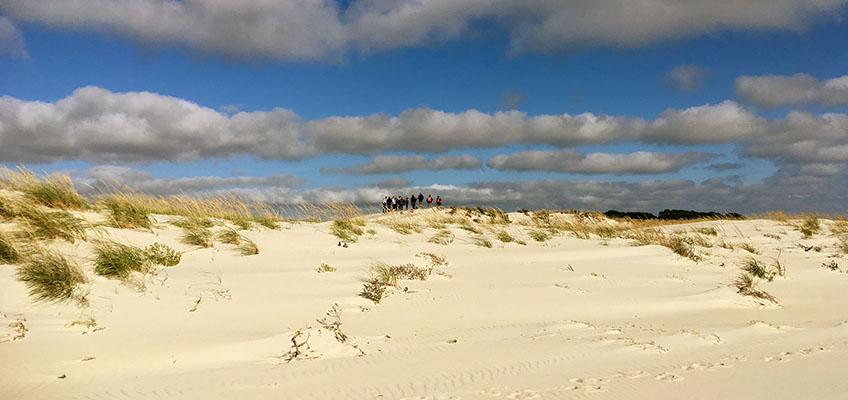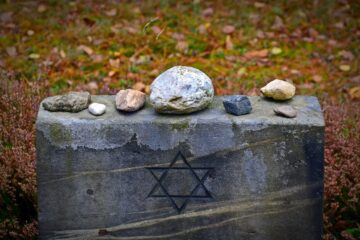GALLOWAY TOWNSHIP – Stockton University scientists are working in the field this summer and with the help of social media, they are bringing the public with them.
Marine science professors will be highlighting some of their field sites and survey methods over the month of June in a weekly Live Lab Days series on Facebook Live. Viewers will get a taste of what it’s like to be a marine scientist at Stockton University. The Marine Science program combines both laboratory and field work to study processes happening in both organisms and their environments.
Winds, tides and the sun determine the timing of marine events, so below is a tentative schedule. The exact dates and times will be posted a few days prior on the NAMS virtual events page.
Aaron Stoler, assistant professor of environmental science, will continue to explore Stockton’s pinelands campus with his muck boots and a smartphone to teach ecology lessons on Facebook Live. His series, called Streaming with Stoler, is visiting the campus farm, greenhouse and Aquifer Thermal Energy Storage system with guest experts.
Student and all nature enthusiasts can follow Stoler’s adventures on the Stockton School of Natural Sciences and Mathematics Facebook page 3 p.m. Fridays. Rain dates occur the following Monday at the same time.
Here is the planned schedule.
June 2, 12 p.m., Crabs, Grass and Mud
You may have heard about the various ways that salt marshes are important, and you probably drive by them on your way to the shore, but have you taken a really close look at one? Follow Susanne Moskalski on a tour through a local salt marsh to discover how a marsh scientist sees them. Moskalski will guide a walk and discussion on topography of the marsh, common flora and fauna, the movement of water, the delivery of sediment, and what goes on below the surface. Moskalski is a coastal sedimentologist who has conducted research in South Carolina and Brittany, France. Information about her classes, student research, and publications can be found at SusanneMoskalski.weebly.com.
Week of June 8, Oyster restoration in Barnegat Bay
For the past four years, Stockton has worked with the Barnegat Bay Partnership, Jetty Rock Foundation, Long Beach Township and Parson’s Mariculture to plant oysters on the Tuckerton Reef, a four-acre site in lower Barnegat Bay. Join us and learn about this valuable habitat as we show you how we plant oysters on the bay bottom and monitor their success and habitat for other species. Dr. Christine Thompson will chat about oyster biology and the many interesting species that inhabit oyster reefs in Barnegat Bay. Dr. Thompson is an Assistant Professor of Marine Science at Stockton University. Her expertise in oysters and other shellfish comes from previous positions at the American Littoral Society, the Horn Point Laboratory in Maryland and Woods Hole Oceanographic Institution. Learn more about this project at https,//stockton.edu/marine/marine-oyster-restoration.html or on IG, @stocktonshellfishlab
June 12, 3 p.m., Stockton’s Aquifer Thermal Energy System
Summer means beaches, sunscreen and air conditioning. Normally, cooling buildings takes A LOT of electricity. Not at Stockton where a system literally sucks the cold out of the ground and blows it into buildings. And during the winter, it takes the cold from the buildings and puts it back into the ground. Patrick Hossay, associate professor of Sustainability, will be a guest for Aaron Stoler’s tour of Stockton’s Aquifer Thermal Energy Storage system.
Week of June 15, Seagrass vs. Seaweed
(Exact date and time to be posted on the NAMS virtual events page)
Ride along with Elizabeth “Z” Lacey, associate professor of Marine Science, as she visits one of her seagrass monitoring sites in Barnegat Bay. Learn about this valuable ecosystem, how to identify seagrass versus seaweed, and how you can play a role in preserving the seagrass habitat. Lacey teaches courses in Marine Biology, Marine Botany and Marine Conservation. Learn more on Instagram at @stockton_merl and online at stockton.edu/merl.
June 19, 3 p.m., Inside the Greenhouse
With the completion of Stockton’s Unified Science Center 2, the university’s newest greenhouse went live last year. This greenhouse has climate control, lighting control, water control and plenty of plants. Greenhouse expert Chrissy Schairer will be a guest with Aaron Stoler for a tour of Stockton’s USC 2 greenhouse. There will be plenty of plants, plenty of flowers and lots of corny jokes.
June 23, 2 p.m., Ask a Marine Scientist
Have a passion for the ocean? Interested in a degree in marine science but not sure if that’s marine biology or oceanography? During this interactive Q&A session, viewers will meet marine science faculty and learn about the research they conduct out of the Marine Field Station. Panelists will explore the career options available and dispel some of the myths behind this fascinating degree. Hint, It’s not all about the dolphins!
June 26, 3 p.m., Farming for the Future
Nestled on the south part of Stockton’s campus, the university maintains a large sustainable farm where faculty and students experiment with novel crops and growing techniques. Plants are produced with organic methods and the crops are always delicious. Ron Hutchison, associate professor of Biology, will be a guest with Aaron Stoler for a tour of the farm.
Week of June 29, Dinosaurs, Sharks, and More Fossils!
The sands of the Coastal Plain of New Jersey record Earth’s history from the time of the dinosaurs through today. Certain layers of the sediments are filled with fossils from these organisms and you can find them yourself! Shark teeth of many different species are the most common, but fish, reptile, invertebrate, and even dinosaur fossils can be found. Join Geology professor Rocky Severs as he explores one of the most well-known fossil areas in the greater Big Brook region and learn about the sedimentary units and the fossils they contain.
Week of July 13, (tentative) Minerals of New Jersey
Most people do not know exactly what minerals are other than they are the building blocks of rocks. However, minerals are the source of most the materials that we use today and go into making buildings, roads, cell phones, solar panels, and much more. New Jersey is home to several world-famous mineral collecting localities, is known as the fluorescent mineral capital of the world and has important economic bodies for different minerals. Join Geology professor Rocky Severs as he takes you to visit a classic mineral locality and talks about how they formed and what uses they have to society.



